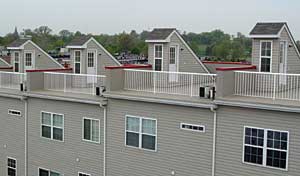Enhancing Roof Deck Performance with PVC Waterproof Membranes
The ABCs of Pedestrian Roof Decks
Pedestrian roof decks are surfaces that are subjected to pedestrian traffic. They can be constructed with a wood or concrete substrate, and can be waterproofed using a variety of materials. Waterproofing systems for wood or concrete decks are typically classified as protected membrane assemblies or as exposed membrane assemblies. In protected assemblies, the waterproofed membranes are protected by another surface, such as concrete pavers, tiles or wood deck boards. In exposed assemblies, the waterproof membrane, which is either a liquid-applied coating or a PVC membrane, is exposed to the elements.
Traditional waterproofing methods in protected assemblies can result in a number of common problems. Wood can rot. Coatings can delaminate. Concrete deteriorates. Over time, costly maintenance and expensive repairs are required to correct these problems.
Liquid coatings can also be problematic. Because concrete substrates tend to shift in response to daily temperature fluctuations, unattractive and potential dangerous cracks can occur. This kind of constant movement can put enormous stress on epoxy, urethane, and acrylic liquid-applied coatings. As a result, pinholes, blisters or surface cracks often occur, allowing moisture to penetrate the membrane and cause further deterioration of the concrete. In addition, incorrect or inadequate surface preparation is a huge reason for failure of liquid coatings.
|
While outdoor carpet may be an attractive option, installed on its own, it is not waterproof. When it does get wet, carpet tends to hold water and dry very slowly. If the carpet is laid without a waterproof membrane underneath, it will allow water to permeate the concrete or wood substrate below, causing it to rot and deteriorate. Furthermore, carpet holds the water close to the deck and doesn't allow it to dry, therefore increasing the potential damage. Beyond that, outdoor carpet fibers tend to deteriorate rapidly through exposure to the sun. Frequently, frayed and unsightly outdoor carpets need to be replaced.
Wood decks have a unique aesthetic appeal. But even treated wood will deteriorate when exposed to the elements. Over time, exposure to moisture will cause wood decking to split, warp, twist, shrink, splinter, crack, and rot. Wood decks, which are also highly combustible and can be slippery when wet, require constant maintenance, regular repainting, and re-staining.
There are difficulties with paver overlays, too. To begin with, the structure has to be designed to accept the additional weight and clearance requirements of the paver system. In addition, drainage is critical to the waterproof membrane underneath the paver system, which is difficult to get at should maintenance, repair or replacement become necessary.
Even PVC membranes are not problem-free. While normal traffic will not damage the vinyl, removing snow, moving furniture, dropping sharp objects, skidding a bicycle tire, a roller blade or the edge of a running shoe across the vinyl creates friction, and the extreme heat and abrasion may possibly remove the print. Consequently, solid-color membranes are advisable for high traffic areas.
PVC membranes may also be affected by the sun. "All products designed for exterior use will eventually be affected by Mother Nature," says John Ogilvie, President, Duradek, Ltd. "PVC is the best attempt at prolonging the life cycle of various building products and performs an admirable job in delaying the inevitable."










